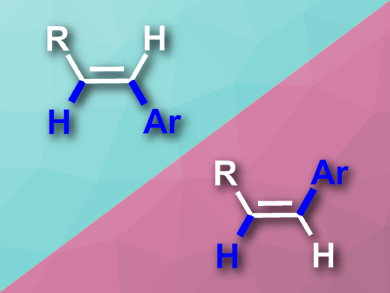To prepare the E and Z isomers of an alkene, generally the synthesis of two different sets of precursors are necessary. Often different synthetic routes are used. Stereodivergent methods that allow the synthesis of both alkene isomers from the same starting materials are known but rare.
Gojko Lalic, University of Washington, Seattle, USA, and colleagues have developed a diastereodivergent method for hydroarylation of terminal alkynes giving access to both isomers of aryl alkenes using the same set of starting materials (aryl bromides and terminal alkynes), and the same combination of catalysts (iPrCuCl/Pd(OAc)2 with iPr = 1,3-bis(2,6-diisopropylphenyl)imidazol-2-ylidene). The hydroarylation reactions are carried out in toluene at 45 °C, they have a broad substrate scope, and provide the desired products in high yields and with high diastereoselectivity.
The method involves a sequence of catalytic reactions promoted by the combination of the palladium and copper catalysts operating in tandem. The Z-selective hydroarylation is achieved through Sonogashira coupling of alkynes and aryl bromides, followed by semireduction. The E-selective hydroarylation involves an additional isomerization of the Z-aryl alkene.
The researchers found that both catalysts are involved in the Sonogashira coupling. The semireduction is predominantly promoted by a copper catalyst in the Z-selective reaction. The palladium catalyst is necessary for both the semireduction and the isomerization in the E-selective reaction. Excess MeOH suppresses the copper-catalyzed semireduction and promotes the alkene isomerization, leading to E-selectivity.
- Diastereodivergent Reductive Cross Coupling of Alkynes through Tandem Catalysis: Z- and E-Selective Hydroarylation of Terminal Alkynes,
Megan K. Armstrong, Madison B. Goodstein, Gojko Lalic,
J. Am. Chem. Soc. 2018.
https://doi.org/10.1021/jacs.8b05113



